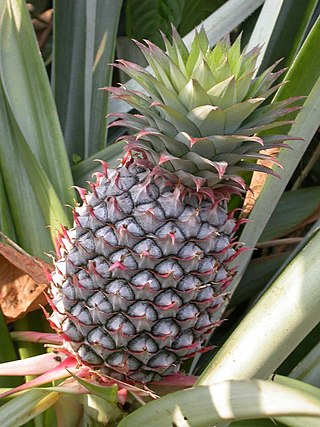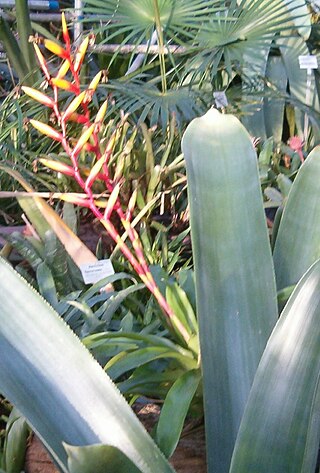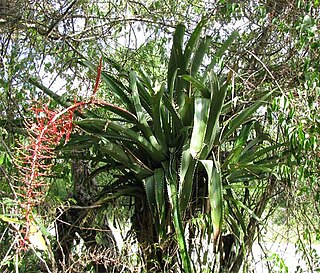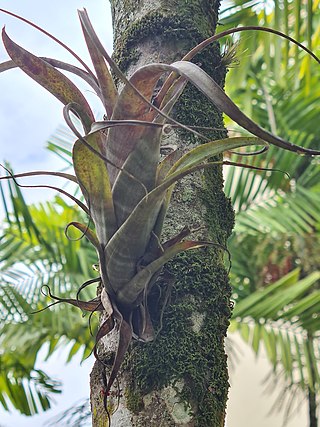
The Bromeliaceae are a family of monocot flowering plants of about 80 genera and 3700 known species, native mainly to the tropical Americas, with several species found in the American subtropics and one in tropical west Africa, Pitcairnia feliciana.

Tillandsia gardneri is a species in the genus Tillandsia. This species is native to Trinidad and Tobago, Colombia, eastern Brazil and Venezuela.

Tillandsia globosa is a species in the genus Tillandsia. This species is native to Brazil and Venezuela.

Tillandsia juncea is a species of flowering plant in the genus Tillandsia. This species is native to northern South America, Central America, Mexico and the West Indies.

Tillandsia paraensis is a species of flowering plant in the genus Tillandsia. This species is native to Bolivia, Peru, Ecuador, Colombia, the Guianas, Brazil and Venezuela.

Tillandsia polystachia is a species of flowering plant in the genus Tillandsia. This species is native to Central America, the West Indies, Bolivia, Colombia, Brazil, Ecuador, Mexico and Venezuela.

Vriesea platynema is a plant species in the genus Vriesea. This species is native to the West Indies and South America.

Vriesea procera is a plant species in the genus Vriesea. This species is an epiphyte native to Trinidad and South America.

Aechmea bracteata is a plant species in the genus Aechmea. This species is native to Central America, Mexico, Colombia, and Venezuela; it is also reportedly naturalized in the Bahamas.

Tillandsia fasciculata, commonly known as the giant airplant, giant wild pine, or cardinal airplant, is a species of bromeliad that is native to Central America, Mexico, the West Indies, northern South America, and the southeastern United States. Within the United States, this airplant is at risk of extirpation from the Mexican bromeliad weevil, Metamasius callizona. A related plant, Tillandsia utriculata, sometimes called the "wild pine", is endemic to the same areas.

Tillandsia flexuosa, the twisted airplant, is a species of bromeliad in the genus Tillandsia. This species is native to Central America, southeastern Mexico, northern South America and the United States (Florida).
Aechmea corymbosa is a plant species in the genus Aechmea. This species is native to Venezuela, Colombia, Peru, Brazil and Ecuador.

Pitcairnia brittoniana is a plant species in the genus Pitcairnia. This species is native to Bolivia, Costa Rica, Venezuela and Ecuador.
Aechmea contracta is a species of flowering plant in the Bromeliaceae family. It is native to Venezuela, Colombia, Peru, Guyana and northern Brazil.

Aechmea politii is a plant species in the genus Aechmea. This species is native to Venezuela, Colombia, Guyana and French Guiana.
Aechmea rubiginosa is a plant species in the genus Aechmea. This species is native to Venezuela, Colombia, Peru, and northern Brazil.

Aechmea tocantina is a species of flowering plant in the Bromeliaceae family. This species is native to northern and central South America.
Puya killipii is a species in the genus Puya. This species is native to Venezuela. A Puya killipii is a species of a flowering plant that belongs to the family Bromeliaceae. The puya killipii is widely distributed and found in the open rocky hillsides, at 3200-3300 m alt. The Puya Killipii is found on the northeastern side of Colombia and adjacent to Venezuela.

Tillandsia complanata is a species of flowering plant in the genus Tillandsia. This species is native to Bolivia, Peru, northern Brazil, Colombia, Guyana, Costa Rica, Panama, Cuba, Jamaica, Trinidad, Venezuela and Ecuador.
Tillandsia turneri is a species of flowering plant in the family Bromeliaceae. This species is native to Venezuela, Colombia, Guyana, and northern Brazil.














